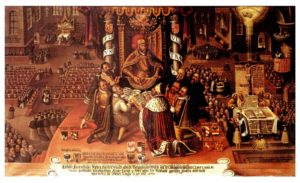Commemoration of the Presentation of the Augsburg Confession
June 25
The Lord be with you
 June 25 is the Commemoration of the Presentation of the Augsburg Confession. The Augsburg Confession is the principal doctrinal statement of the theology of Martin Luther and the Lutheran reformers. It was written largely by Philip Melanchthon. At its heart, it confesses the justification of sinners by grace alone, through faith alone, for the sake of Christ alone. Signed by leaders of many German cities and regions, the confession was formally presented to Holy Roman Emperor Charles V at Augsburg, Germany, on June 25, 1530 (hence the name of the confession and the date selected to commemorate it). A few weeks later, Roman Catholic authorities rejected the Confession, which Melanchthon defended in the Apology of the Augsburg Confession (1531). In 1580, the Unaltered Augsburg Confession was included in the Book of Concord, which contains all the confessions of the Lutheran Church.
June 25 is the Commemoration of the Presentation of the Augsburg Confession. The Augsburg Confession is the principal doctrinal statement of the theology of Martin Luther and the Lutheran reformers. It was written largely by Philip Melanchthon. At its heart, it confesses the justification of sinners by grace alone, through faith alone, for the sake of Christ alone. Signed by leaders of many German cities and regions, the confession was formally presented to Holy Roman Emperor Charles V at Augsburg, Germany, on June 25, 1530 (hence the name of the confession and the date selected to commemorate it). A few weeks later, Roman Catholic authorities rejected the Confession, which Melanchthon defended in the Apology of the Augsburg Confession (1531). In 1580, the Unaltered Augsburg Confession was included in the Book of Concord, which contains all the confessions of the Lutheran Church.
The Augsburg Confession consists of twenty-eight “articles.” Each article addresses a specific topic, like “God,” “Original Sin,” “the Son of God,” and so forth. Each article is presented in a logical sequence so article 1 flows naturally into article 2 which flows naturally into article 3, and so on. These articles can also be divided into three groups. Group one, which deals with doctrine, are points on which no compromise was seen as possible. From the tone of the Augsburg Confession, it was expected that these doctrinal points would, largely, not be controversial. That is probably why so many of them are quite short. They were included to accent common ground and to indicate that doctrinally the Lutheran Confessors were standing on the same ground the Church has always stood. The second group of articles dealt with abuses in the Roman Church. The third dealt with areas in which the Evangelicals thought discussion could profitably be engaged The harsh response from the representatives of Rome took the Lutherans by surprise, but the Princes stood their ground.
It is traditional to use Roman Numerals when listing the articles of the Augsburg Confession. Below is a list of the articles
I. God
II. Original Sin
III. The Son of God
IV. Justification
V. The Ministry
VI. New Obedience
VII. The Church
VIII. What the Church Is
IX. Baptism
X. The Lord’s Supper
XI. Confession
XII. Repentance
XIII. The Use of the Sacraments
XIV. Order in the Church
XV. Church Ceremonies
XVI. Civil Government
XVII. Christ’s Return for Judgment
XVIII. Free Will
XIX. The Cause of Sin
XX. Good Works
XXI. Worship of the Saints
XXII. Both Kinds in the Sacrament
XXIII. The Marriage of Priests
XXIV. The Mass
XXV. Confession
XXVI. The Distinction of Meats
XXVII. Monastic Vows
XXVIII. Church Authority
The Augsburg Confession is a relatively short document. Without notes and commentary, it is only about 30 pages long. You may read the Augsburg Confession for yourself by following this link:
The above is an especially helpful posting of the Augsburg Confession because, with each article, you can click on the “Confutation.” The Confutation was the official Roman response to the Augsburg Confession.
Prayer: Lord God, heavenly Father, You preserved the teaching of the apostolic Church through the confession of the true faith at Augsburg. Continue to cast the bright beams of Your light upon Your Church that we, being instructed by the doctrine of the blessed apostles, may walk in the light of everlasting life; through Jesus Christ, our Lord, who lives and reigns with You and the Holy Spirit, one God, now and forever. Amen.
Blessings in Christ,
Pastor John Rickert
